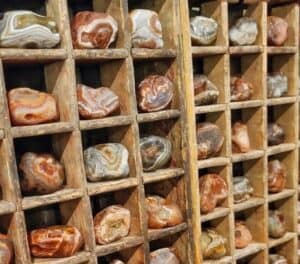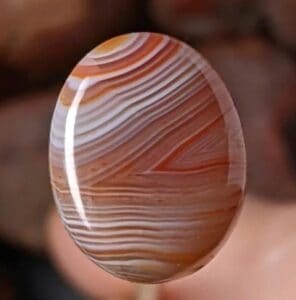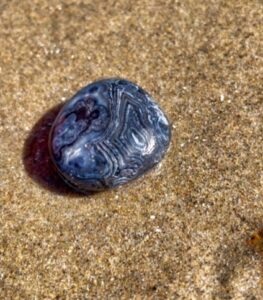Lake Superior Agates are all the rage on YouTube because they’re a ton of fun to hunt for, collect, and polish. As the name suggests, you can find these nodules on the shores of Lake Superior which makes the experience of looking for them a lot of fun.
The biggest difference between Lake Superior Agates and other Agates is their rich red, orange, and yellow colors which are caused by the oxidation of iron. The higher the concentration of iron the deeper the color between the bands.
Lake Superiors or Superiors come in various sizes but large nodules are rarely found. While exploring for these agates you’ll come across nodules ranging from golf ball size up to grapefruit size.

Types of Lake Superior Agate
Before we get into the types of Lake Superior Agate we should take a minute and understand how they form. Lava flows are responsible for creating these amazing agates. As the lava solidified, carbon dioxide and water vapor trapped within these flows created millions of tiny bubbles. Later, groundwater transported silica, ferric iron, and other dissolved minerals through the trapped gas bubbles. That same water deposited the quartz-rich solution which leads to the concentric bands you see in agates.
While there isn’t a wide variety of Lake Superior Agate, you will find unpolished, polished, and blue Lake Superior Agate. Let’s take a look at them.

Unpolished Lake Superior Agate
Lake Superior Agates are typically shaped as irregular spheres. They’re comprised of Quartz that’s often reddened by iron deposited in layers, creating concentric circles that display themselves as rings on the cross-section of a tree.
These agates will range from around the size of a pea up to 20 pounds, which is extremely rare. Unpolished stones display shades of red, orange, and yellow with the banding breaking the surface. You’ll need to wet the stone to have a better idea of the quality.
While unpolished specimens don’t seem to shine as brightly as those that are polished, they’re still beautiful. The swirling patterns are usually visible, but in some samples, you’ll have to take a closer look.

Polished Lake Superior Agate
Lake Superior Agates take a high polish which means the detail in the banding and the exceptional color is on full display. The reds range from bright to dull, rusty color. Some specimens will have evidence of Quartz in the center that looks like ice spreading across a window. The concentration of iron and the amount of oxidation will determine the color within the Agate’s bands.
Not only will you find red and orange, but there can also be white, grey, black, and tan strips of color as well.

Blue Lake Superior Agate
Blue Lake Superior Agates contain shades of cobalt blue which makes them the most sought-after due to their rarity. Some nodules will contain small patches or sections of blue inside of the nodule but every now and again you’ll find a solid blue nodule with banding. As you can see from the image above, they have a tendency to look black or dark blue-grey.
Where To Find Lake Superior Agate
Glacial activity naturally spread Agates throughout northeastern and central Minnesota, Northern Iowa, Michigan’s Upper Peninsula, northwestern Wisconsin, and around Thunder Bay in Northwestern Ontario, Canada. Lake Superior Agates have been found throughout the gravel deposits along the Mississippi River basin. However, there are other types of Agate similar to the Lake Superior variety that have been found in southwestern Wisconsin.
The iron-stained Lake Superior Agates are found along the shores of Lake Superior. The stone’s wide distribution and beautiful banding of color reflect the geological history of Wisconsin, Minnesota, Iowa, Nebraska, and Michigan. In 1969 this variety of Agate was designated by the Minnesota Legislature as the state’s official gemstone.
Now you know where the stones are, but we’re going to tell you precisely what to look for. While there is no simple answer, the richly colored banding pattern isn’t well exposed, so prospectors have to look for the following clues to help them identify a Lake Superior Agate.
- The band planes along which the Agates have broken are sometimes visible, which gives the rocks a peeled texture. It looks as though the bands were partially peeled off, similar to a banana peel.
- Look for iron-oxide staining. It’s found on nearly all Agates to a degree, and it generally covers much of the rock. This staining can be of various colors, but the most common shades of rusty red and yellows.
- An optical feature Chalcedony Quartz produces is translucence, one of the principal constituents of Agates. The Quartz allows light to penetrate, which produces a glow. Sunny days are the best time to observe translucence.
- There is usually a waxy, glossy appearance, especially on chipped or broken surfaces.
- Pitted textures often cover the rock surface where the stones are present. They are the result of projections or knobs from an initial layer of softer mineral matter that gets deposited on the walls of the cavities where the Agates are formed. The projections leave impressions on the exterior, hence the pitting.
- Identify Enstatite - March 12, 2024
- Identify Cerussite - March 3, 2024
- Identify Bytownite - February 18, 2024
